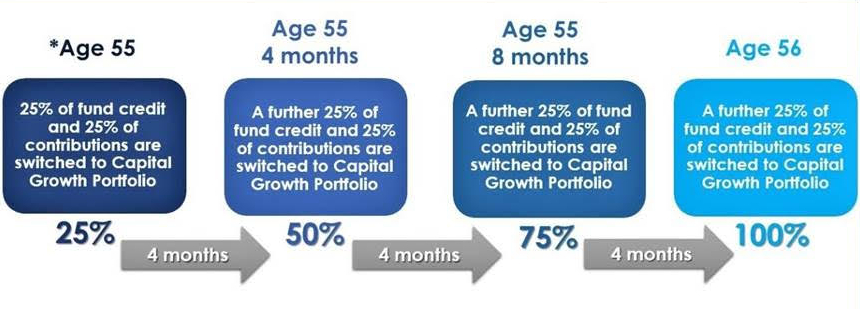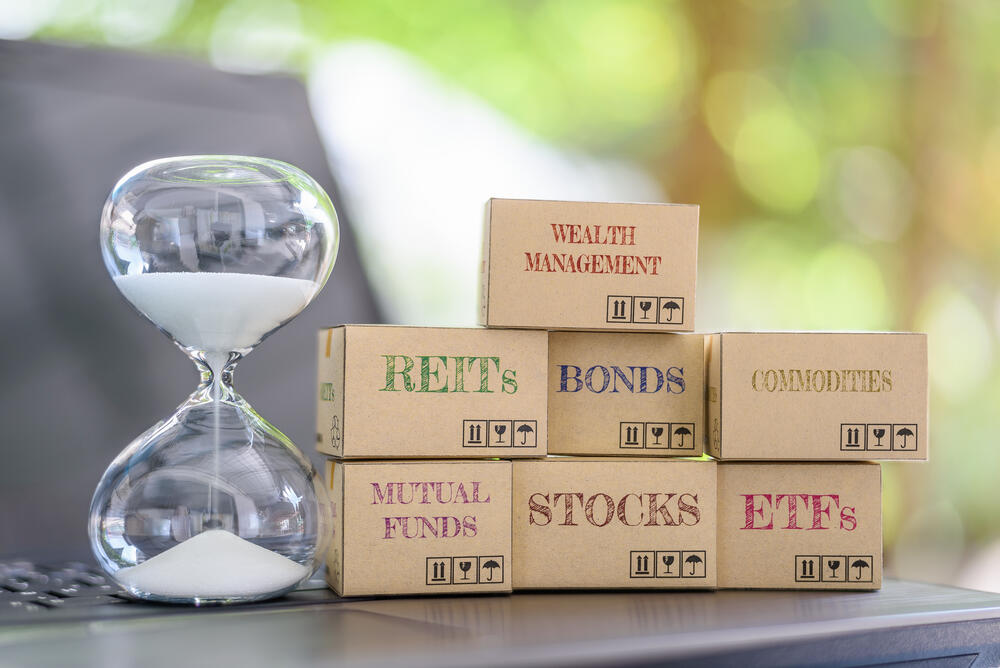Investments
Life stage (default)
The fund applies a life stage model which automatically takes members through different investment portfolios i.e. aggressive to more conservative portfolios as they near retirement age. The life stages are as follows:
- Members younger than age 55 - Aggressive Growth portfolio
- Members age 55 and older, but younger than age 62 -Capital Growth portfolio
- Members age 62 and older - Stable Growth portfolio
The fund has implemented a phasing-in approach for default switches. Read more
The first 25% switch to the new recommended portfolio will commence at the end of a member’s birthday month. As a result, it will take 12 months for a total portfolio switch to be completed. After the 12 month phase-in period, all future member contributions will automatically accrue to the new default life stage portfolio. See an illustration of a default switch from the Aggressive Growth portfolio to the Capital Growth portfolio below.

*The first 25% switch to the new recommended portfolio will commence at thee end of a member's birthday month.
Member investment choice
The fund also allows flexibility in providing our members with the option to elect any of the individual investment portfolio options available.
Investment switch form
Aggressive Growth Portfolio
Investment objective: To maximise capital growth over a long-term investment horizon. Members should acknowledge that this strategy could deliver volatile and negative returns over the short-term. This strategy is suitable for members with more than 10 years to retirement.
Capital Growth Portfolio
Investment objective: :To target capital growth over a medium to long-term investment horizon. Members should acknowledge that this strategy could deliver volatile and negative returns over the short-term. This strategy is suitable for members with 5 to 10 years to retirement.
Stable Growth Portfolio
Investment objective: To target stable returns over a medium-term investment horizon with low volatility and a low probability of negative returns. This strategy is suitable for members with 1 to 5 years to retirement.
Capital Protector Portfolio
Investment objective: To provide capital security with very low volatility and an extremely low probability of negative returns. This strategy is suitable for members with less than 1 year to retirement where capital protection is absolutely necessary
Shari’ah portfolio
This portfolio is suitable for Muslim investors requiring a Sharia-compliant investment portfolio. The portfolio will be invested in a variety of domestic and international asset classes. The underlying investments will comply with Shari'ah requirements as prescribed by the Auditing Organisation for Islamic Financial Institutions. The portfolio targets capital growth over the long-term while limiting short term market fluctuations.
Latest investment returns

Economic Commentary: November 2025
The rally in global markets paused in November as technology stocks declined on the back of increasing concerns about the surge in AI-related capex and the limited impact on productivity thus far.
In the US, inflation was not measured for October as the Bureau for Labor Statistics could not collect data for the month due to the US government shutdown. The consensus forecast is for a 3% increase from a year earlier (unchanged from September) as some underlying price pressures eased. With little clarity on the state of the economy, the expectations for further interest rate cuts changed with each data release. At month end, Fed Fund futures were pricing in an 87% chance of a December rate cut as the outlook for jobs growth weakens and inflation remains steady. Meanwhile, the delayed release of retail sales data showed that consumption increased less than expected in September as consumer sentiment wanes on the back of higher prices. Preliminary data on Black Friday sales show that spending increased by just 4% from a year ago (or 1% in real terms), with the bulk of the increase attributed to higher earners. The bifurcation in spending suggests that the US is experiencing a K-shaped economy - where higher earners are supported by growth in their investments and homes while lower earners live hand to mouth. The temporary pause in the Supplemental Nutrition Assistance Program benefits due to the government shutdown has also caused increased stress in lower income consumers.
Global markets traded sideways in November as investors rotated to traditionally defensive sectors as concerns about AI spending and profitability grew. The MSCI World Index ended the month with a gain of 0.3% as strength in healthcare, communication services, and materials stocks offset weakness in technology and consumer discretionary stocks. The US’ S&P500 also ended the month up 0.3%, while the tech-heavy NASDAQ recovered from an intra-month loss of 8% to end the month down just 1.6% as expectations for US rate cuts soothed investors’ concerns about technology company valuations. S&P 500 company earnings have generally been solid, with a blended growth rate of 13.4% for the companies that have reported to date (95% of the S&P 500). Reactions to strong earnings have however been subdued as investors’ expectations remain high, while reactions to earnings or revenue misses have been disproportionately severe. Emerging markets meanwhile fell 2.4%, as losses in China, South Korea, and Taiwan offset gains in Brazil, South Africa, and Mexico. Global bond markets gained 0.2% as yields on developed market government bonds dipped slightly, while global property stocks added 1.9% on rate cut expectations.
In South Africa, inflation increased slightly to 3.6% in October (from 3.4% in September) mainly driven by higher costs for transport and recreation, while food and restaurant prices cooled. South Africa has officially ratified a new inflation target of 3%, with a 1% tolerance band on either side, replacing the previous 3-6% range. The new target was agreed upon by the Minister of Finance and the Governor of the South African Reserve Bank (SARB), and announced as part of November’s Medium-Term Budget Policy Statement (MTBPS). The change is intended to anchor inflation expectations, improve price stability, and align with international best practices. Other key announcements in the MTBPS include measures to increase spending efficiency, a forecast of 1.8% GDP growth over the medium term, efforts to combat illicit trade, and structural reforms to improve public service delivery through municipalities. With higher tax revenue and lower debt servicing costs thanks to lower bond yields, the budget deficit is expected to decline from the current 4.5% of GDP to 2.7% by 2028/9, while the debt-to-GDP ratio is expected to stabilise at 77%.
Local equity markets gained for a ninth consecutive month as foreign sentiment towards the local market improved. The All Share Index gained 1.7% for the month, as a 10% gain in resources stocks offset a 12% decline in index heavyweight Naspers. Financials gained 2.2% thanks to strength in banks, while industrials shed 5.3% as a sharp decline in Naspers’ share price offset gains in British American Tobacco and Richemont. Retailers also struggled as the outlook for consumption remains uncertain. The rand strengthened 1% for the month, boosted by a surprise upgrade of the nation’s credit rating by S&P Global Ratings. Local bonds gained 3.4% as bond yields declined sharply on the back of increased foreign buying following a positive MTBPS and the increased possibility of another credit rating upgrade in the new year. Listed property stocks surged 7.7% on the back of the sharp decline in bond yields and good operating performance.
 NFMW AG FFS November 2025
NFMW AG FFS November 2025
 128 kb
128 kb
 NFMW CG FFS November 2025
NFMW CG FFS November 2025
 125 kb
125 kb
 NFMW SG FFS November 2025
NFMW SG FFS November 2025
 154 kb
154 kb
 NFMW CP FFS November 2025
NFMW CP FFS November 2025
 132 kb
132 kb
 NFMW Sharia FFS November 2025
NFMW Sharia FFS November 2025
 146 kb
146 kb
Investment policy statement
Investments FAQs




 Cookie Notice
Cookie Notice Cookie settings
Cookie settings